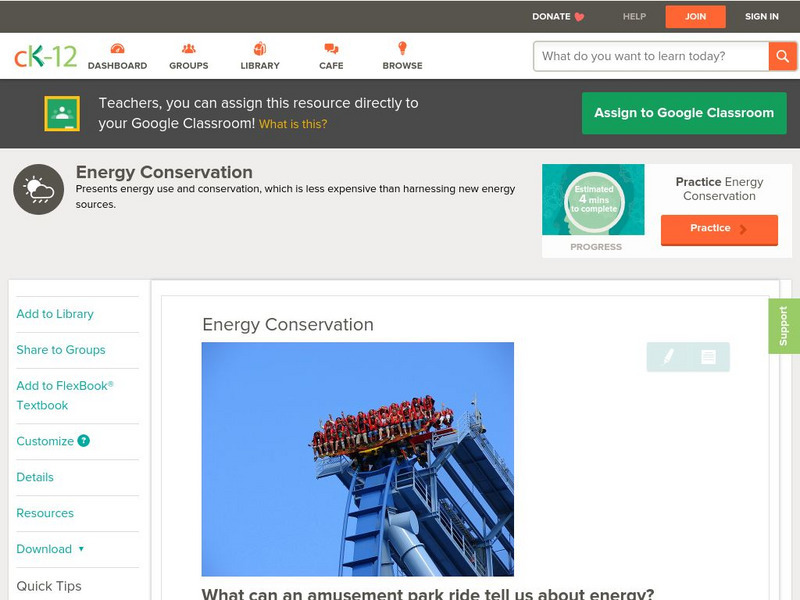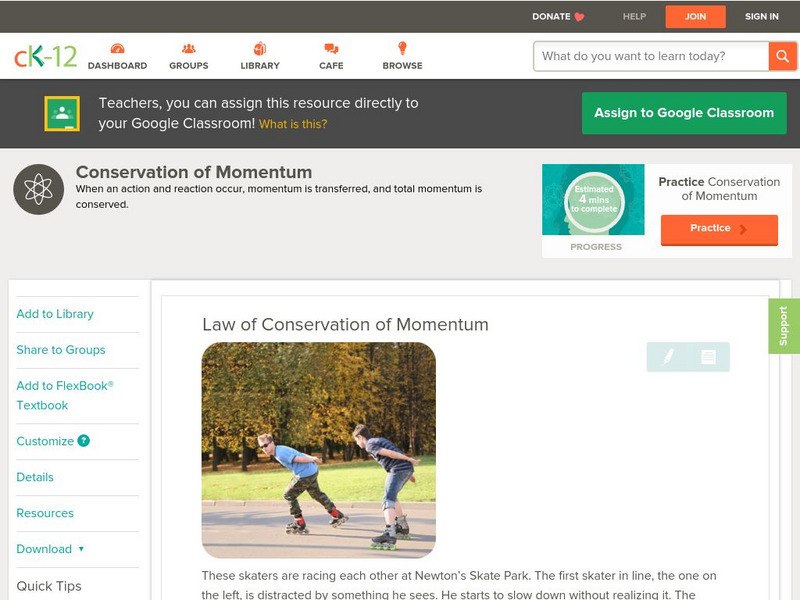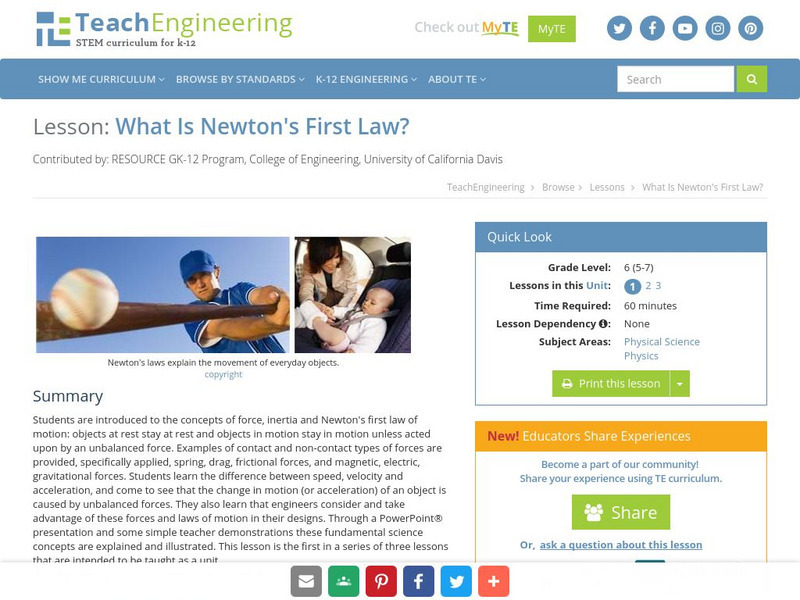CK-12 Foundation
Ck 12: Physical Science: Position Time Graphs
[Free Registration/Login may be required to access all resource tools.] How motion and speed can be represented by a distance-time graph and how average speed can be calculated from it.
CK-12 Foundation
Ck 12: Earth Science: Energy Conservation
[Free Registration/Login may be required to access all resource tools.] Overview of how energy is used, and how it can be conserved.
CK-12 Foundation
Ck 12: Earth Science: Introduction to Energy Resources
[Free Registration/Login may be required to access all resource tools.] Overview of the types of energy, and how it can be stored and released.
CK-12 Foundation
Ck 12: Earth Science: Introduction to Energy Resources
[Free Registration/Login may be required to access all resource tools.] Overview of the types of energy and how it can be stored and released.
CK-12 Foundation
Ck 12: Physical Science: Law of Conservation of Momentum
[Free Registration/Login may be required to access all resource tools.] The law of conservation of momentum and how it is transferred and conserved.
Sophia Learning
Sophia: Newton's Second Law: Lesson 3
This lesson introduces Newton's Second Law and explains that force is equal to mass times acceleration. It is 3 of 3 in the series titled "Newton's Second Law."
TeachEngineering
Teach Engineering: Changing Fields
This lesson begins with an activity in which students induce EMF in a coil of wire using magnetic fields. Then, demonstrations on Eddy currents show how a magnetic field can slow magnets just as Eddy currents are used to slow large...
TeachEngineering
Teach Engineering: Art in Engineering Moving Art
Students learn how forces are used in the creation of art. They come to understand that it is not just bridge and airplane designers who are concerned about how forces interact with objects, but artists as well.
CK-12 Foundation
Ck 12: Physical Science: Projectile Motion
[Free Registration/Login may be required to access all resource tools.] Projectile motion and combining forces, examples of projectile motion.
Michigan Reach Out
Nasa: Soda Pop Can Hero Engine
Students explore all three parts of Newton's Laws of Motion by observing a spinning pop can.
Physics Classroom
The Physics Classroom: Motion and Forces in Two Dimensions: Vectors/direction
The emphasis of this unit is to understand some fundamentals about vectors, and to apply the fundamentals in order to understand motion and forces that occur in two dimensions.
Physics Classroom
The Physics Classroom: Motion and Forces in Two Dimensions: Relative Velocity
Through illustrated examples and interactive practice problems, students explore problems that involve relative velocity- where the actual motion of an object is different than its motion relative to a stationary observer.
TryEngineering
Try Engineering: Tinkering With Tops
Lesson explores the history, design, and motion of spinning tops. Student teams design and build their own tops that can spin for at least 10 seconds within a circle 30 centimeters in diameter.
Physics Classroom
The Physics Classroom: Circular and Satellite Motion: Newton's 2nd Law Revisited
In this interactive module, students use free-body diagrams, Newton's second law equation, and circular motion concepts to analyze a variety of physical situations involving the motion of objects in circles or along curved paths.
Physics Classroom
The Physics Classroom: Vectors: Forces in Two Dimensions:equilibrium and Statics
Through examples and practice problems, this interactive tutorial helps students understand forces that are in a state of equilibrium with a net force of zero.
Physics Classroom
The Physics Classroom: Motion and Forces in Two Dimensions: Vector Addition
In this physics tutorial, the task of summing vectors will be extended to cases in which the vectors are directed in directions other than purely vertical and horizontal.
Physics Classroom
The Physics Classroom: Motion and Forces in Two Dimensions: Component Addition
In this physics tutorial, students learn how to approach more complex vector addition situations by combining the concept of vector components and the principles of vector resolution with the use of the Pythagorean theorem.
Physics Classroom
The Physics Classroom: Work, Energy, and Power: Mechanical Energy Is Conserved
In this interactive exercise, explore the quantitative relationship between work and mechanical energy in situations in which there are no external forces doing work.
Physics Classroom
The Physics Classroom: Circular and Satellite Motion: Weightlessness in Orbit
Through illustrated examples and practice problems, this interactive physics tutorial helps students clear up their possible misconceptions about weightlessness.
TeachEngineering
Teach Engineering: What Is Newton's First Law?
Students are introduced to the concepts of force, inertia, and Newton's first law of motion: objects at rest stay at rest and objects in motion stay in motion unless acted upon by an unbalanced force.This lesson is the first in a series...
TeachEngineering
Teach Engineering: What Is Newton's Third Law?
Students are introduced to Newton's third law of motion, and then learn that engineers apply Newton's third law and an understanding of reaction forces when designing a wide range of creations, from rockets and aircraft to door knobs,...
TeachEngineering
Teach Engineering: Mechanics Mania
Through ten lessons and numerous activities, students explore the natural universal rules engineers and physicists use to understand how things move and stay still. Together, these rules are called "mechanics." The study of mechanics is...
TeachEngineering
Teach Engineering: Surface Tension
Surface tension accounts for many of the interesting properties we associate with water. By learning about surface tension and adhesive forces, students learn why liquid jets of water break into droplets rather than staying in a...
Utah STEM Foundation
Utah Stem Action Center: Angry Birds Are Mad About Physics
Learn about catapults and Newton's laws of motion.













